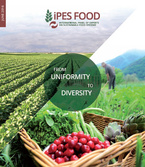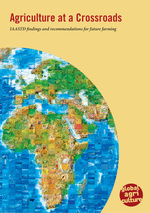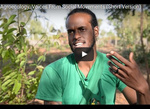Agriculture at a Crossroads - Business as Usual is Not an Option!
Why should 795 million people on our planet be going hungry while 1.9 billion are suffering from the ill effects of overweight and obesity? In 2016 more grain was harvested than ever before: 2.5 billion tons worldwide. Despite this record-breaking harvest, only 43% was used to feed people. The rest was used to feed livestock, fill our petrol tanks, support industrial production processes or was simply wasted. Our global food system is one of the most significant contributors to climate change, loss of biodiversity, pollution and water shortages as well as preventable disease, poverty and injustice.
On behalf of the United Nations and the World Bank, in a four-year-process, more than 400 scientists summarised the state of global agriculture, its history and its future. The outcome was the International Assessment of Agricultural Knowledge, Science and Technology for Development (IAASTD). The findings are uncomfortable and alarming: providing a warning on the misleading ways of the past and showing new ways forward. This website makes the IAASTD’s findings available by topics, and offers all reports as well as updated figures, background information and news.
Global news update:
14/03/17 +++ One in four North American bee species at risk of extinction, report warns +++ NEW
09/03/17 +++ UN experts call on states to phase out pesticides and promote agroecology +++
07/03/17 +++ Bolivia: Agroforestry and organic cacao increase farmers' income +++
03/03/17 +++ Lower pesticide use rarely decreases yields and income, French study +++
22/02/17 +++ EU rejects patents on conventionally bred plants and animals +++
17/02/17 +++ Organic is booming: 50.9 million hectares worldwide farmed organically +++
07/02/17 +++ Herbicide-resistant superweeds on the rise in U.S. Midwest, university report +++
02/02/17 +++ Climate change may cut some US crop harvests by half, study warns +++
New brochure: IAASTD findings and recommendations for future farming
Business as usual is not an option, if we want to reduce hunger and poverty, improve rural livelihoods and achieve environmentally, socially and economically sustainable development for all. This was the message of the “International Assessment of Agricultural Knowledge, Science and Technology for Development” (IAASTD). The new brochure “Agriculture at a Crossroads” presents the report’s main findings with updated facts and figures, charts and maps and the latest scientific insights. The 52-page-brochure covers topics such as hunger and health, meat and animal feed, industrial and small-scale farming, agroecology, climate and energy, soil fertility and land grabbing. It connects the IAASTD’s findings to the UN Sustainable Development Goals and contains an interview with IAASTD co-chair Hans Herren.
Download the brochure here.
New Landmatrix report shows scale of the global land rush
10/16: Since the year 2000, foreign investors have acquired 26.7 million hectares of land around the globe for agriculture, with Africa being the most affected continent. This means that around 2 per cent of the arable land worldwide, or roughly the equivalent to an area the size of the United Kingdom and Slovenia together, has been transferred into the hands of foreign investors. That is the message of a new report released by the Landmatrix, an independent initiative that collects and evaluates data on large-scale land acquisitions. The report can downloaded here.
Farming Matters: Making the case for agroecology

9/16: This issue of Farming Matters explores innovative ways to show that agroecology provides critical solutions to the challenges of our time. Agroecology is gaining recognition for its potential to address climate change, biodiversity loss and malnutrition, and there are many successful example. However, to garner the necessary support in policy and practice, looking differently at ‘progress’, ‘performance’ or ‘success’ of farming and food systems is key. As agroecology can have impact at many levels, conventional indicators such as yield per hectare of a single crop no longer suffice. The experiences, opinions, and perspectives featured in this issue demonstrate how farmers, researchers, policy makers and consumers are using new lenses to track change. Some authors point out that evidence alone is not enough to achieve an agroecological transition, and that the ‘movement’ dimension of agroecology is crucial.
One year into the SDGs: Goals for a world without hunger and poverty

9/16: 25 September marked the first anniversary of the 2030 Agenda for Sustainable Development. One year ago, the 193 UN Member States adopted 17 Sustainable Development Goals (SDGs) and a set of 169 targets that aim to end poverty and hunger in all their forms by 2030 while protecting the environment. Eliminating hunger is a key issue of the new post-2015 agenda. Goal 2 promises to „end hunger, achieve food security and improved nutrition and promote sustainable agriculture”. It contains targets on ending hunger and malnutrition by 2030, doubling the agricultural productivity and incomes of small-scale farmers, ensuring sustainable food production systems and resilient agricultural practices, and maintaining the gentic diversity of seeds, plants and animals.
Food experts urge global shift towards agroecology

6/16: Input-intensive crop monocultures and industrial-scale feedlots must be consigned to the past in order to put global food systems onto a sustainable track, according to a team of experts on food security, agro- ecosystems and nutrition. The solution is to diversify agriculture and reorient it around ecological practices, whether the starting point is highly-industrialized agriculture or subsistence farming in the world’s poorest countries, they argue. The International Panel of Experts on Sustainable Food Systems (IPES-Food), led by former UN Special Rapporteur on the right to food, Olivier De Schutter, published its findings in the report From uniformity to diversity. The authors call for diversified agroecological systems. We have summarised the main messages of the report.
Agroecology: Voices from social movements
9/15: A movement is growing. While agroecology has been practiced for millennia in diverse places around the world, today we are witnessing the mobilisation of transnational social movements to build, defend and strengthen agroecology as the pathway towards a most just, sustainable and viable food and agriculture system. This video, created as part of a research project at Coventry University, explores the meaning, practice and politics of agroecology from a social movement perspective.
2000m²: Take a look at your share of gobal food and land!
If we were to divide the total global surface area of arable land by the number of people living on the planet, each person would get 2000m². It is on this piece of land that everything Mother Earth supplies you with must grow: wheat, rice, potatoes, fruit, vegetables, oil, sugar… not to mention all the animal feed that does not stem from meadows and pastures. Visit the website of this new ARC2020 project to find out what your 2000m² would look like if they were to represent the global situation and to learn how much tomatoes, cabbages, carrots, wheat and potatoes could be grown on your field. www.2000m2.eu





